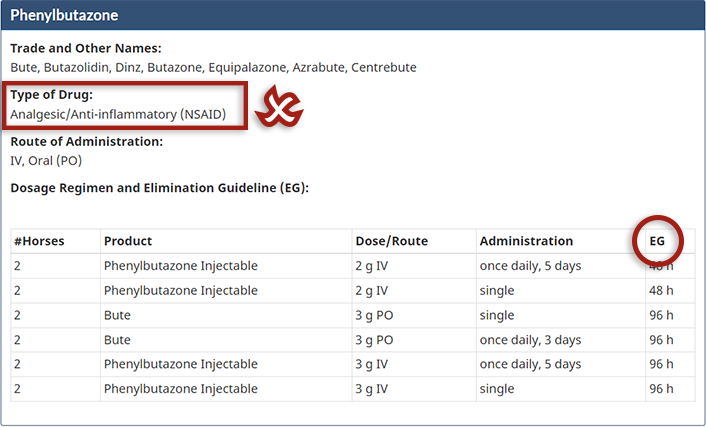Attention: Owners, Trainers, Licensed Veterinarians
Regulated Substances with CPMA Elimination Guidelines
As of January 1, 2024, horses participating in Official Workouts and Qualifiers must not test positive for the following categories of medications that have a Canadian Pari-Mutuel Agency (CPMA) Elimination Guideline:
- Analgesic: A drug that relieves pain
- Anti-inflammatory: A drug that relieves local swelling, redness and pain caused by an injury or infection
- Local Anaesthetic (Anesthetic): A drug producing reduced sensations (e.g., touch, pain) in a restricted area of the body
- Non-steroidal Anti-Inflammatory (NSAID): Non-steroidal anti-inflammatory drug.
- Corticosteroid: A drug producing an action similar to that of a steroid hormone of the adrenal cortex, but which is chemically distinguishable from natural hormones
These medications can mask pain associated with injuries and/or have been tied to an increased risk of injuries and fatalities. The restrictions on these medications are aimed at protecting horses and ensuring they are only training at high speeds when they are well enough to do so.
The following information provides additional clarity on TB Rule 15.40.01 and SB Rule 6.54.01 testing requirements, examples of regulated substances not included in the CPMA Elimination Guidelines but falling under the restricted categories (mentioned above), and guidance on navigating the CPMA Elimination Guidelines website.
All AGCO licensees are expected to stay up to date with the Rules of Racing.
Regulated Substances without CPMA Elimination Guidelines
- Regulated: Medications with properties of the above restricted categories that do not have a CPMA Elimination Guideline.
- Examples: Celecoxib, Robenacoxib, Mavacoxib.
Additional Medication Information
- Regulated: Topical preparations (including heel creams) and throat washes containing substances that fall into the above restricted categories.
- Regulated: Products with even one medication or substance that falls into the above restricted categories.
- Example: Naquasone (available as a compounded formulation) containing Trichlormethiazide and Dexamethasone. Trichlormethiazide is not regulated as a diuretic, but Dexamethasone is regulated as a corticosteroid, so the entire product is regulated.
- Requirement: Procaine penicillin can be administered before an Official Workout or Qualifier in the same manner as it can be administered before a race. For a race, submitting a procaine slip may be required. For a Workout or a Qualifier, submitting a procaine slip will not be required.
- Requirement: Labeling of dispensed medications by Licensed Veterinarians in accordance with these rules is required.
- Requirement: Consult with your Licensed Veterinarian when considering whether to administer medications.
Horse Selection and Notification Process
- If a horse is selected for testing following an Official Workout or Qualifier, an AGCO or an official representative (ie. Official Veterinarian) will notify the licensee (trainer, assistant trainer, exercise rider, jockey, driver, groom) before the horse returns to their stall in the paddock or barn.
Additionally:- Standardbred horses selected for testing will be notified by the starter after the qualifying race before their return to the paddock.
- Thoroughbred or Quarter horses selected for testing will be notified before the horse returns to the stable. In most circumstances, this notification will occur through two methods, such as notification at the gap and by overhead announcement.
- If the horse selected for testing after a Workout or Qualifier experiences a medical emergency, the horse may be examined and treated by a Licensed Veterinarian.
- For Standardbred horses, the Licensed Veterinarian or trainer must contact the AGCO Race Officials immediately afterward.
- For Thoroughbred or Quarter horses, the Licensed Veterinarian or trainer must contact the AGCO immediately afterward via the person who informed them of the selection or email vetclerks@agco.ca.
Navigating the CPMA Elimination Guidelines Website
The categorization of medications and substances are clearly identified within the CPMA Elimination Guidelines , under the Type of Drug heading. Licensees should refer to the Type of Drug and EG sections under each medication.
Example of restricted drug/substance – NOT ALLOWED

Source: Canadian Pari-Mutuel Agency (CPMA)
Example of allowed drug/substance – PERMITTED
